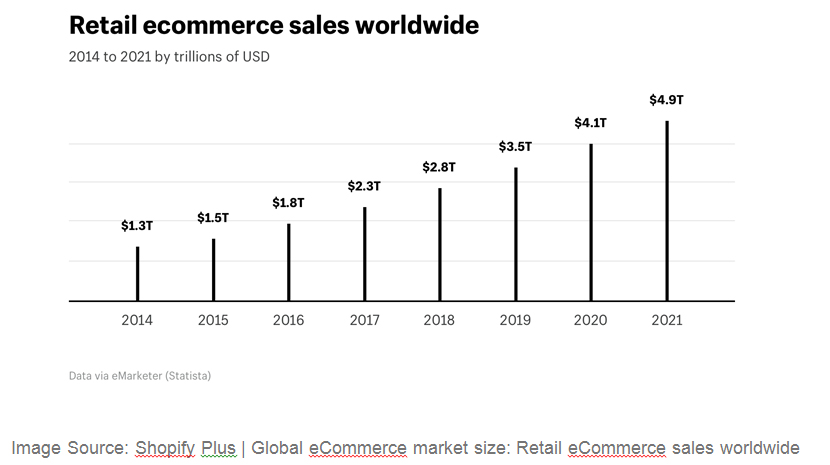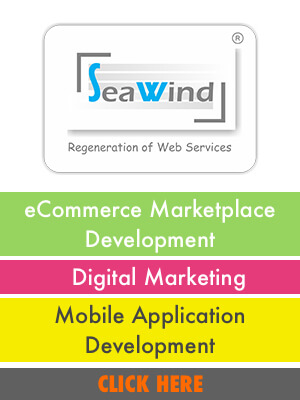Ecommerce now plays a vital role in our daily lives. It is redefining commercial activities around the world. Over the years, eCommerce has evolved in profound ways. As we proceed, we will learn about the growth of eCommerce and how to run an eCommerce business in this age.
The E-commerce Explosion
Let us look at statistics and trends that depict the growth of eCommerce globally. To describe the growth of eCommerce according to a report published in 2019 by Aaron Orendorff to help business launch beyond borders.

Image Source: Shopify Plus | Global eCommerce market size: Retail eCommerce sales worldwide
The report presents statistics and trends about eCommerce since 2014 and also gives estimates of the future of eCommerce up to 2023. Cumulative data over the most-recently tracked period anticipates a 276.9% increase in eCommerce sales globally.
Things to Note
- As Internet penetration and accessibility increases, more people can benefit from the majority of online services, including eCommerce.
- E-commerce has become mainstream in people’s daily lives with profound benefits.
- The eCommerce sector is expected to break the net accounting for double-digit growth in all locations around the world. Of course, the highest emergency market growth rates are in the Asia-Pacific and Latin America regions. Countries in these regions are responsible for the greatest eCommerce market success. Also, as digital payment options becoming more prevalent in these regions, eCommerce will thrive immensely.
- As of now, about 22% of the world shops online.
- Retail eCommerce sales may reach $5 trillion by 2021.
Major Drivers of the Explosion
Let us look at the main factors that are responsible for the growth of eCommerce globally in a small time frame.
The Rise in the Use of Mobile Devices
The rise in the use of mobile devices globally has contributed to the growth of eCommerce. With mobile devices, people are buying and selling over the Internet more flexibly and passively.

Also, companies are transforming payment methods, making them secure and simple to effect transactions. E-commerce businesses rely on these payment systems and are integrating them into their mobile applications. Customers are now more than ever, hooked to their mobile devices with fingers ready to pay.
Data-driven Nature
Statistical observations gathered by eCommerce businesses have also contributed to the growth of eCommerce. In the Business to Consumer model, eCommerce businesses track consumer preferences and make remarkable observations. These observations are then integrated into retail models for seamless future purposes, ensuring that eCommerce sales soar globally.
Improved Consumer Experiences
Consumers are usually in search of product offers at very affordable or discount prices. Personalization holds a higher command on customer engagement. Customers frequently encounter new product offers that match their interests and they can get with simple taps of buttons, without having to move their feet.
Low Cost
Another important factor responsible for the growth of eCommerce is the low cost of running an eCommerce business. Unlike brick-and-mortar stores, it is relatively cheaper to establish an online store than a physical one. E-commerce eliminates the need to build physical stores in which products are cataloged.
Also, eCommerce stores are accessible from any part of the world over the Internet. As a result, eCommerce stores are more accessible to customers globally and provide a passive experience for commercial activities.
E-commerce Giants: Everybody Wants to Rule the World
The eCommerce sector has become broad and diverse. However, some giants are ruling the eCommerce world. These are businesses that have established a monopoly of some sort and immense credibility in the eCommerce sector.
The most popular eCommerce businesses worldwide are Amazon, Alibaba, eBay, and Walmart. These eCommerce giants have redefined the retail industry irrespective of location. They accumulate revenues that exceed billions of dollars yearly. As internet accessibility increases, these estimates would skyrocket. At the time of this writing, Amazon is present in 58 countries, Alibaba in 15, Walmart in 27, MercadoLibre in 18.
Powering an E-commerce Store
At the moment, we have a fair understanding of how eCommerce has grown in the past years. The question many people ask today is,
“How can we launch an eCommerce store?”
When you consider the level of competition that exists in the eCommerce sector, this becomes an important question. However, the thought that the demand for goods and services is always rising is a comforting fact. Also, the giants that rule the eCommerce world today have already answered that question.
There
are many ways to launch an eCommerce store, but, an effective one that is
cost-saving and guarantees support is to use an eCommerce platform like JoineCom.
An eCommerce platform is a software solution that allows businesses to build
and manage online storefronts. A storefront is any customer or business facing
proposition relating to the selling of products and services. These platforms
provide everything a business needs to sell online, on social media, or in
person.
Benefits of an E-commerce Platform
Running an eCommerce store using an eCommerce platform helps you to:
- Sell on a Global Scale: Using a single platform to sell products to anyone, anywhere — online with your eCommerce store, online marketplaces, and social media, and in-person with point of sale.
- Market your Business: Use built-in marketing tools that help you create, execute, and analyze campaigns on Facebook and Google.
- Manage your Business: Use a single dashboard to manage orders, shipping, and payments anywhere you go. Use insights provided to grow your business.
Consumer Experiences
Just as eCommerce is changing the retail industry, it is also changing consumer experiences in so many ways. In eCommerce, consumer experience revolves around three key aspects:
Consumers who shop online do so at their convenience, wherever, and whenever they want. Unlike brick-and-mortar stores, consumers don’t need to be physically present at the storefront to effect a purchase. At the consumer’s comfort, he or she can swipe through products and with the push of a button (or a few) complete a purchase. As a result, this saves time and guarantees satisfaction. Of course, this is very important to the consumer.
E-commerce businesses go the extra mile of personalizing consumer experiences. Consumer experiences can be tailored based on the consumer’s past transactions. E-commerce platforms use insights obtained from consumers’ histories to suggest product offers that match their interests.
By shopping online, consumers save a lot of time, money, and other valuable resources. All consumers need to do, is place an order at a convenient time and location, and it is then made available to them.







Post your comments
You must be logged in to post a comment.